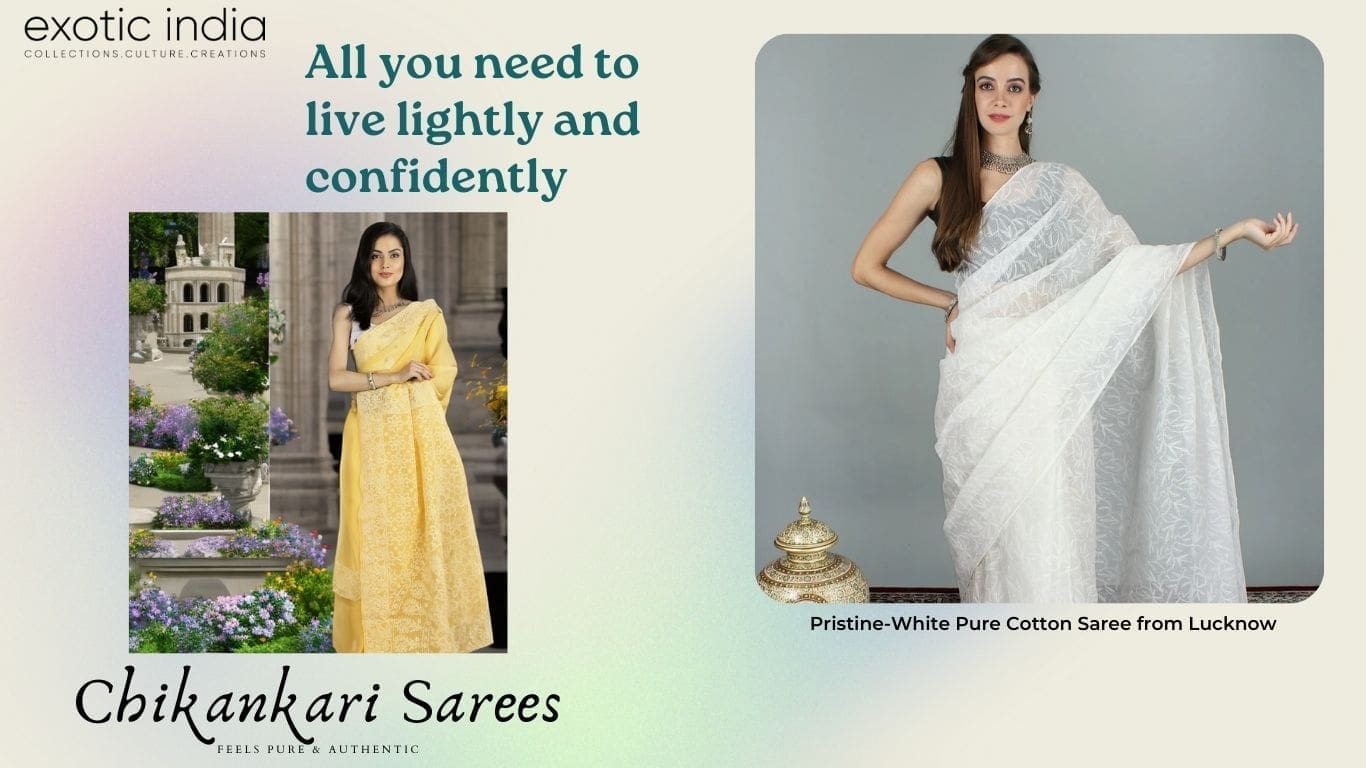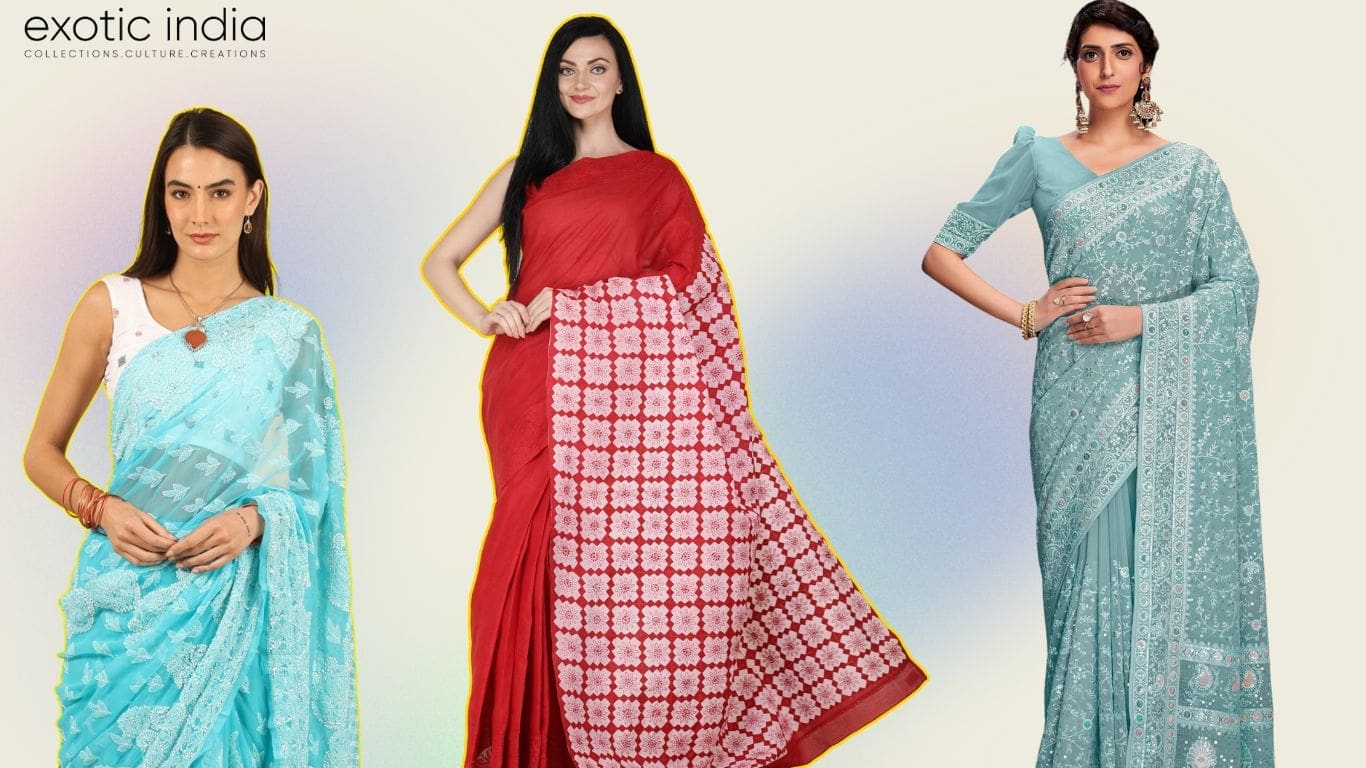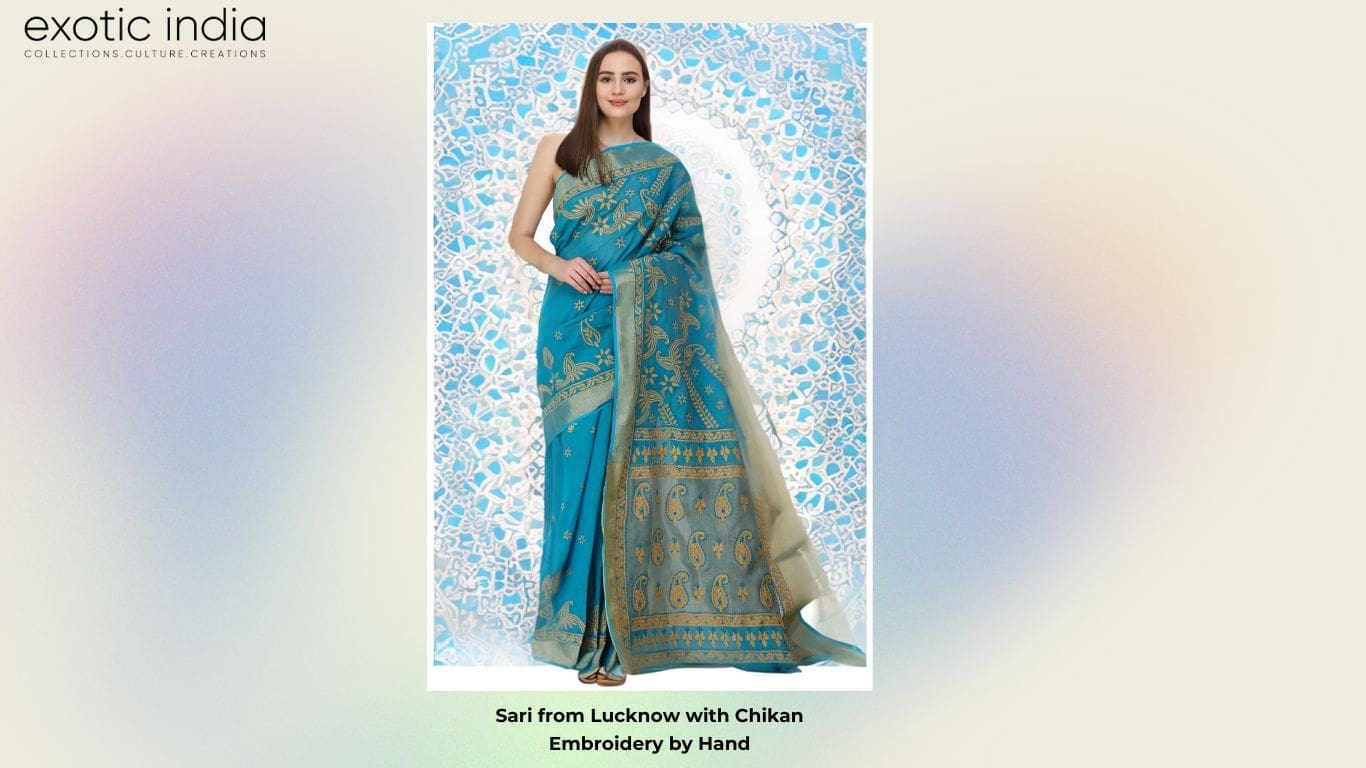Uttar Pradesh is known for its unique and exquisite embroidery style called chikankari. The art of chikankari involves delicate embroidery using white thread on fine muslin or cotton fabric, creating intricate patterns and designs. The embroidery is done on the fabric after it has been pre-washed and starched, ensuring that the threads sink into the fabric and become a part of it. The embroidery is usually done by hand, using a variety of stitches, including satin stitch, stem stitch, and French knots.
 Pure Cotton Chikankari Sarees From Lucknow – Exotic India
Pure Cotton Chikankari Sarees From Lucknow – Exotic India
Chikankari has a rich history in Uttar Pradesh, dating back to the Mughal era. The art form is said to have originated in Lucknow, which was once the center of the Awadh region. The Mughal emperors were known to be great patrons of chikankari, and it soon became popular among the royal court and the nobility. Over the years, the art form evolved and spread to other parts of Uttar Pradesh, including Kanpur, Agra, and Varanasi. Today, chikankari is a popular embroidery style, not just in India, but also around the world, with fashion designers incorporating it into their collections and fashion-conscious people seeking out chikankari sarees, suits, and accessories.
Uttar Pradesh is a special state in India due to its rich cultural, historical, and religious significance. The state has a diverse and vibrant culture, with a mix of Hindu, Muslim, and other religions. The state is home to many historic cities, including Agra, Varanasi, and Lucknow, which have played a significant role in Indian history and culture. Uttar Pradesh is also known for its iconic monuments, including the Taj Mahal, one of the Seven Wonders of the World, and the magnificent temples of Varanasi. The state is also home to many other historical and architectural marvels, such as the Fatehpur Sikri and the Bara Imambara. The state of Uttar Pradesh is also known for its contribution to Indian literature, music, and arts. The state has produced many legendary poets, musicians, and artists, including Kabir, Tulsidas, and Pandit Ravi Shankar. The traditional art forms of Uttar Pradesh, such as chikankari embroidery, brassware, and pottery, have gained worldwide recognition and appreciation.
Intricate and Delicate Embroidery
 Lucknowi Chikankari Sarees Designs – Exotic India
Lucknowi Chikankari Sarees Designs – Exotic India
Chikankari sarees are known for their intricate and delicate embroidery, which features a variety of designs and patterns. Some of the prominent designs on chikankari sarees include:
- Paisley Design: The paisley design is a popular motif in chikankari sarees. The design features a teardrop-shaped motif, which is often used to create an all-over pattern on the saree. This is often decorated with intricate designs such as floral patterns, paisleys, or geometric shapes. The paisley design is believed to have originated in Persia and was introduced to India during the Mughal era. It quickly became popular among the Indian royalty and nobility and has since become a popular design element in Indian textiles and embroidery. The paisley design is a classic and timeless motif that adds a touch of elegance and sophistication to any fabric or garment.
- Floral Design: The floral design is another popular motif on chikankari sarees. The design features delicate and intricate embroidery of flowers, leaves, and vines.
- Geometric Design: The geometric design is a modern interpretation of chikankari embroidery, featuring geometric shapes and patterns such as triangles, squares, and diamonds.
- Peacock Design: The peacock design is a popular motif in chikankari sarees, representing grace and elegance. The design features the beautiful and intricate embroidery of peacock feathers, which creates a stunning visual effect on the saree.
- Buti Design: The buti design is a small, all-over motif that is commonly used on chikankari sarees. The design features tiny dots, flowers, or paisley motifs, creating a subtle yet beautiful effect on the saree. The Buti design typically features small dots, flowers, or paisley motifs that are repeated all over the fabric, creating a cohesive and intricate pattern. The origin of the Buti design is not well-documented, but it is believed to have originated in ancient India. The design has been used in various forms of Indian art, including textiles, paintings, and architecture. In chikankari embroidery, the Buti design is often used as a subtle compliment to larger motifs, such as florals, paisleys, or geometric patterns. The Buti design adds texture and depth to the fabric, creating a unique and beautiful effect that is distinctively Indian.
Story of The Lucknowi Tradition

Chikankari, also known as Lucknowi Chikan, Lucknow Chikankari, or Chikan Embroidery, has been a renowned craft in Lucknow for over 200 years. The loss of artisans and industry following the collapse of the Mughal court resulted in its patronage by Nawabs. While most clothing is stitched before embroidery, items such as suit material, skirts, Chikankari saris, and table linen are embroidered first and then finished. More than 5000 families in and around remote villages of Lucknow are involved in the Chikankari embroidery industry.
Chikankari is a unique and distinctive hand embroidery technique with a vast range of stitching methods that cannot be reproduced. The origins of Chikankari are enigmatic and mythical, with references to Indian Chikan work found as early as the third century BC. There are many stories about the origins of Chikankari embroidery, including one where a traveller passing through a hamlet near Lucknow taught a poor farmer the skill of Chikankari as thanks for his hospitality. Another story dates back to the Mughal court of Jahangir, where his queen Nur Jahan’s love for Chikan embroidery helped it gain prominence and imperial patronage.
The varieties of Chikankari
- Rahet is a stitch that is not often used in its basic form but is commonly employed in the double version of Dora bakhiya. It is a stemmed stitch that is used to create a chain-like pattern that resembles a rope. The stem of the stitch is visible on the surface of the fabric, while the loops are hidden underneath. It is often used to create intricate designs and patterns on fabrics like sarees, suits, and dupattas.
- Banarasi is a type of knotted stitch that is made on the right-hand side of the cloth using six threads. This stitch is known for its durability and strength and is commonly used to create intricate designs on fabrics like Banarasi Chikankari sarees. These sarees are famous for their intricate designs, which are made using the Banarasi stitch. The Banarasi stitch is also used in combination with other stitches to create unique patterns and designs on fabrics.
- Khatau is a type of appliqué that is similar to Bakhia but finer. The design is created on calico, which is then embroidered onto the surface of the finished cloth using paisley and flower designs. Khatau is often used to create intricate designs on fabrics like sarees and suits. This type of embroidery requires a lot of skill and patience, as the designs are very intricate and detailed.
- Taipchi is a long-running or darning pattern that is used to highlight a particular theme. It is often used to create borders or to highlight specific designs on fabrics like sarees and suits. Taipchi can be done in a variety of colors and is often used in combination with other stitches to create unique and intricate designs.
- Bahia is a type of shadow labor that is classified into two types: multi and sidhi. Multi Bahia involves creating a pattern using several rows of stitches that overlap, while sidhi Bahia involves creating a pattern using a single row of stitches. Bahia is often used to create intricate designs on fabrics like sarees, suits, and dupattas.
- Phanda is a type of millet-shaped stitch that is used to create flowers and motifs such as grape vines. It is a simple stitch that is often used to create intricate designs on fabrics like sarees, suits, and dupattas.
- Murri is a type of rice-shaped micro stitching that is used to create intricate designs on fabrics like sarees, suits, and dupattas. It is a very fine stitch that requires a lot of skill and patience to execute properly.
- Jali is a type of embroidery that is traditionally worked by ripping the threads of the material and forming minute buttonhole stitches. It is often used to create intricate designs on fabrics like sarees, suits, and dupattas.
- Keel Kangan is a material that is used to embellish floral designs and butties. It is often used in combination with other stitches to create unique and intricate designs on fabrics like sarees, suits, and dupattas.
- Hool is a little detachable eyelet stitch that is made with six strands and resembles the heart of a flower. It is often used to create intricate designs on fabrics like sarees, suits, and dupattas.
- Zanzibar is a type of stitch that is used to delineate the leaf/petal forms after one or more outlines have been done. It is often used to create intricate designs on fabrics like sarees, suits, and dupattas. The Zanzibar stitch is known for its durability and strength and is often used in combination with other stitches to create unique and intricate designs.
How is it Manufactured?
To manufacture traditional Lucknowi Chikankari garments, delicate hand stitching is done on plain or light-colored fabrics, with Muslin and Mulmul being the initial fabrics used. However, due to the fashion industry’s expansion, Chikankari is now done on a range of fabrics such as silk, cotton, georgette, chiffon, and net. The process begins with fabric cutting and styling, followed by printing of designs onto semi-stitched cloth using dye-dipped pattern blocks. Then, artisans embroider over the printed fabric using various chikan stitches like Bakhiya, Phanda, Keel Kangan, and Pechni to create intricate designs such as motifs or butis. The fabric is then washed and starched to remove the blue dye and to achieve rigidity. Colored threads are used on the white foundation cloth for Chikankari embroidery on drapes, dupattas, table linen, and kurtas. Although Chikankari is primarily done on cotton, other fabrics such as mulls/malmal, maslins, organzas, and polyester may also be used. Colors and patterns change seasonally to reflect market trends.
Key Takeaways
- Chikankari sarees are known for their delicate and intricate embroidery work.
- They originated in Lucknow, India and have been around for over 200 years.
- They are made using a variety of fabrics including cotton, silk, and chiffon.
- The embroidery is typically done in white thread on a colored or white background.
- Chikankari sarees are popular for both casual and formal occas
